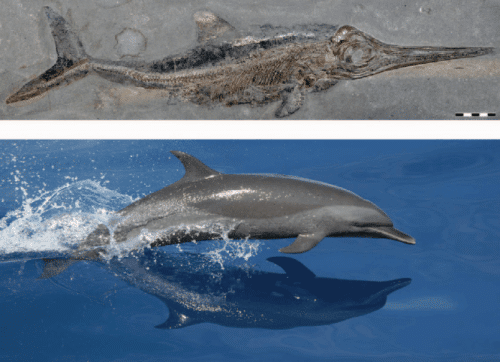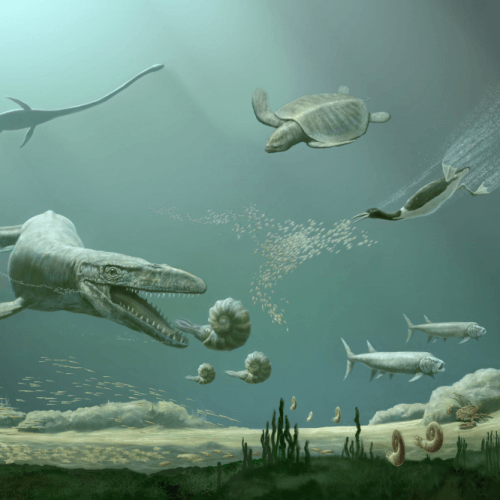In a scientific review conducted by scientists at the Smithsonian Institution, they summarize decades of scientific discoveries to illuminate the common and unique patterns that caused the extraordinary transition of whales, dolphins, seals and other species that moved from land to sea and what caused the extinction of similar sea creatures that were based on reptiles that dominated the days during the dinosaur era

For over 250 million years, land four-legged creatures have repeatedly conquered the oceans of the Earth. These creatures such as plesiosaurs, penguins and sea turtles are descendants of groups of vegetarian animals that descended to the sea and developed an evolution that allowed them to thrive in the marine environment.
In a scientific review conducted by scientists at the Smithsonian Institution, they summarize decades of scientific discoveries to illuminate the common and unique patterns that caused the extraordinary transition of whales, dolphins, seals and other species that moved from land to sea. By drawing on recent breakthroughs in various fields such as paleontology, molecular biology and ecological conservation, the findings give a complete look at the question of how life in the oceans has responded to environmental changes over time. The article also illustrates how evolutionary history provides us with insight into the impact of human activities on marine species today. The article was published in the April 17 issue of the journal "Science".
Marine four-limbed creatures represent diverse groups of living or extinct species of mammals, reptiles, amphibians, and birds that all play, or have played, a critical role as large predators in the marine environment. The repeated transition between land and sea drove innovation, adaptation and diversity against the backdrop of changing marine systems and mass extinctions since the Tertiary period. In this way, they provide models for testing hypotheses about species over long periods of time.
The existing species of four-limbed marine creatures suffer from a series of effects of human activity on their environment, including climate change, damage to habitats, ship collisions and underground noises.
"We know from the fossil record that in the previous times when a significant change occurred in the oceans, these were important turning points in the evolutionary history of marine species," says Neil Kelly, a postdoctoral fellow in the Department of Paleobiology at the National Museum of Natural History. "The oceans continue to change, and a significant part of the change is due to human activity. This research provides an evolutionary context for understanding how existing species of marine predators will evolve to adapt to life in the Anthropocene.
Recent studies of fossils are providing new insight into the evolution of traits that allowed four-limbed land creatures to survive in the sea. In several cases, a similar anatomy developed in different lineages that adapted themselves to life at sea. For example, the dolphins and the extinct marine reptile ichthyosaurs originate from different families of terrestrial species, but they developed a similar body, with the appearance of a fish, despite the huge time difference between them - 50 million years.

The repeated transformation of legs adapted for walking on land to flippers is another example of convergent evolution. Different species such as seals and mosasaurs separately developed front legs that fit in the flow and moved from living on land to the sea, and these limbs allowed them to move easily and efficiently in water. The origin of this transformation may be in parallel changes at the genome level.
"The transitions from land to sea occurred dozens of times among reptiles, mammals and birds, after all the great extinctions," says Nicholas Fainson, curator of marine mammal fossils at the museum. "These creatures always look similar, but the convergence does not end just under the skin. It can be seen on different scales, from the molecules to the food chain, for hundreds of millions of years."
Deep-diving species such as beaked whales and seals have separately developed oxygen-binding proteins called myoglobin in their muscles that allow them to survive underwater for long periods of time. The scientists also discovered identical genetic sequences in various marine species such as whales, seals and manatees. The question of whether this molecular similarity is also responsible for the patterns seen on a large scale of convergent evolution or whether the convergent anatomy was formed by different genetic pathways in different groups remains open and will be resolved when genomic sequences of these species become available.
Not all adaptations observed in marine four-limbed animals can be attributed to convergent evolution. For example, when baleen whales evolved to live underwater, they developed a food filtering system that depends on hair-like surfaces instead of teeth. In contrast, toothed whales have evolved to capture prey by producing sounds and using echolocation, a type of sonar, to process the echoes of these noises and detect objects in the sea.
Kelly and Fainson compiled research from existing studies and relied on the fossil collection at the Smithsonian Institution during the study. The intention was that this comprehensive review would encourage future collaborations between researchers from all scientific fields to lead to new insights about evolutionary biology, paleontology and conservation of the marine environment.

13 תגובות
I wonder how the crocodile always survives
interesting
An ornamental growth of a tree called bilobed ginkgo saved a living fossil from extinction. Therefore, it is worthwhile to establish a reproductive nucleus that is only dedicated to living fossils,
Hi Avi, when you try to send a link - the page refreshes but the message does not appear, nor is there any indication whether it was received in the system or not.
(Usually a message "The response is waiting for confirmation" appears, this time there is nothing)
As for biology, all living fossils are in danger of extinction (except the crocodile). Animals such as: sea turtle, shark, sphenodon (a species of lizard). and the round-tongued black-bellied toad (a toad that lives in Israel).
Eitan, I think you are a positive person. Indeed, whoever mixes biology and politics, opens the gates of hell! But since I believe that democracy and the media in Israel have a flawed structure. So I used this fine website to provoke thought/discussion. And I still think that according to history if it remains fixed this country will disappear, just like the beautiful fossils in the pictures.
I started the comments to sneer at certain people who imagine that an innocent article about the evolution of marine mammals is littered with metaphors for local politics and history but the correspondence is starting to worry.
Either there is an attempt at humor here and if so, the joke is on me, or it turns out that I am mocking a person with borderline personality disorder.
In any case, this discussion does not make me feel good.
In my opinion, Israel could have managed without a Chinese operation and without the first and second Lebanon wars. Kuwait is a democratic country, as is Tunisia, Turkey, a democracy on the level of Israel, that is, on the brink of dictatorship. Lebanon is a brittle and fragile democracy like Iraq. Iran, Jordan, and Egypt are dictatorships with democratic nuances. So Israel It is a border democracy but not the only one. Cyprus is considered a member of the European Union.
From my side
I stand behind my words: "All wars are just" and "Israel is the only democracy in the Mazat"
I challenge you to find one reference in the article that contradicts the above claims that it turns out I made.
Moreover, I challenge you to find one reference in the article that verifies the above claims.
The irony is that the state is a structure contrary to nature but will end up alive as in nature. As in the past, social tension and corruption will cause the death of the state. Everyone knows about suspicions of corruption in the Prime Minister's house but are afraid to report it. You are hypocritical and pathetic with Etan. But you will continue to recite clichés like "all wars are just" ""Israel is the only democracy in Zet", just as anti-Semitism has not disappeared, and so are other human weaknesses such as phobias. Not gone so the patterns will repeat themselves! Continue to lick Netanyahu, because you are like another animal in the herd who is afraid of the leader - maybe like Stalin's fans.
experience response.
Asa, you are wrong and misleading
The article clearly talks about the deterministic cycle (it turns out which words are synonymous) in women's shoe fashion of the last 150 years.
Nature shows us in a way that is not implied in two faces, that if we do not learn from the past, we are doomed to return to the fashion of leggings that corrupted every good part in the 70's and 80's of the 20th century.
Ironically nature shows us that fashion is a living thing and it is our job to protect it.
(Full disclosure: I'm not entirely sure what irony is)
If we compare the determinisms (a process that repeats itself) in the history and politics of the Kingdom of Judah and the Third House ie Israel. Then the country is expected to be destroyed once again. In other words, just as the conditions of the sea allow for an evolutionary pattern that repeats itself. So will Israel end up again! But since evolution is the kingdom of the unexpected, then there is a chance to avoid the fate of the first and second kingdom of Judah. In order to save Israel, we need free and critical communication! But in today's Israel, the media is weak and subject to strong government influence, i.e. regulation, licenses and supervision. Today there is no real criticism of the government and this is a danger to Israel's future. Ironically, nature shows us that the country is a living creature that must be preserved!